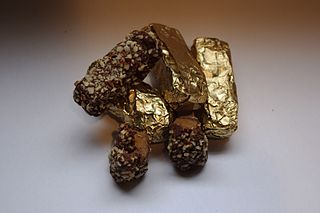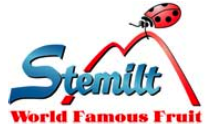
Confectionery is the art of making confections, which are food items that are rich in sugar and carbohydrates. Exact definitions are difficult. In general, however, confectionery is divided into two broad and somewhat overlapping categories: bakers' confections and sugar confections. The occupation of confectioner encompasses the categories of cooking performed by both the French patissier and the confiseur.

Cashmere is a city in Chelan County, Washington, United States. It is part of the Wenatchee–East Wenatchee Metropolitan Statistical Area. The population was 3,248 at the 2020 census.

Wenatchee is the county seat and most populous city of Chelan County, Washington, United States. The population within the city limits in 2010 was 31,925, and has increased to 35,508 as of 2020. Located in the north-central part of the state, at the confluence of the Columbia and Wenatchee rivers near the eastern foothills of the Cascade Range, Wenatchee lies on the western side of the Columbia River, across from the city of East Wenatchee. The Columbia River forms the boundary between Chelan and Douglas County. Wenatchee is the principal city of the Wenatchee–East Wenatchee, Washington Metropolitan Statistical Area, which encompasses all of Chelan and Douglas counties. However, the "Wenatchee Valley Area" generally refers to the land between Rocky Reach and Rock Island Dam on both banks of the Columbia, which includes East Wenatchee, Rock Island, and Malaga.

East Wenatchee is a city in Douglas County, Washington, United States. The population at the 2010 census was 13,190, a 129.1% increase on the 2000 census, having annexed much of the East Wenatchee Bench CDP. As of 2019, the Office of Financial Management estimates that the current population was 14,219.

Orondo is an unincorporated community in Douglas County, Washington, United States, located alongside the eastern part of the Columbia River. It is part of the Wenatchee–East Wenatchee Metropolitan Statistical Area. The area is well known for its robust agriculture industry, and produce fruits such as apples, cherries and pears. The name was derived from a mythical Great Lake Indian and was first settled in the late 19th century by late Washington politician, John B. Smith.

Azwell is a small unincorporated community in Okanogan County, Washington, United States.

Liberty Orchards is a packaged food products company located in Cashmere, Washington. Founded as an apple farm in 1918 by Armenian business partners Armen Tertsagian and Mark Balaban, the company moved into canning and then confectionery during the 1930s and 1940s.

U.S. Route 97 in the U.S. state of Washington is a 322-mile (518 km) route which traverses from the Oregon state line at the northern end of the Sam Hill Memorial Bridge in Maryhill, north to the Canada–US border in Okanogan County near Oroville. The highway serves major cities such as Goldendale, Yakima, Ellensburg and Wenatchee before continuing towards the Alaska Highway at the Yukon border as British Columbia Highway 97. Along the length of the roadway, US 97 is concurrent with State Route 14 in Maryhill, Interstate 82 (I-82) and US 12 between Union Gap and Ellensburg, I-90 briefly in Ellensburg, US 2 between Peshastin and rural Douglas County and SR 20 near Omak. An alternate route connects the highway with Chelan.

Almond Roca is a brand of chocolate-covered, hard toffee with a coating of ground almonds. It is similar to chocolate-covered English toffee. The candy is manufactured by the Brown & Haley Co. of Tacoma, Washington, founded in 1912 by Harry Brown and J.C. Haley.

Stemilt Growers, owned by the Mathison family, is a family-owned tree fruit growing, packing and shipping company based in Wenatchee, Washington. Stemilt is the largest fresh market sweet cherry shipper in the world, and one of the nation's largest grower-packer-shippers of apples, pears, cherries, and stone fruit. Its signature apple varieties include Piñata, Honeycrisp, Gala, and Pink Lady. The company is also a leader in organic fruit production, producing 26% of Washington's organic apples and 32% of the Pacific Northwest's organic pears. In 2008, the company shipped over 20 million boxes of fruit and employed 1,500 people full-time.

Turkish delight or lokum (/lɔ.kʊm/) is a family of confections based on a gel of starch and sugar. Premium varieties consist largely of chopped dates, pistachios, hazelnuts or walnuts bound by the gel; traditional varieties are often flavored with rosewater, mastic gum, bergamot orange, or lemon. Other common flavors include cinnamon and mint. The confection is often packaged and eaten in small cubes dusted with icing sugar, copra, or powdered cream of tartar to prevent clinging. In the production process, soapwort may be used as an emulsifying additive.
Dryden is a small unincorporated community in Chelan County, Washington, United States. It is situated along the Wenatchee River in the fertile Wenatchee Valley between the towns of Cashmere and Leavenworth. The community serves as a supply and shipping point for local farms and orchards.
The northwestern U.S. state of Washington's economy grew 3.7% in 2016, nearly two and a half times the national rate. Average income per head in 2009 was $41,751, 12th among states of the U.S.

Cosmic Crisp is an American apple with the variety designation 'WA 38'. Breeding began in 1997 at the Washington State University (WSU) Tree Fruit Research and Extension Center in Wenatchee, Washington, and was initially overseen by Bruce Barritt. Kate Evans completed the research after Barritt's retirement from WSU.
Ludwig O. Solberg was an architect based in Wenatchee, Washington.
WA 64 is a hybrid apple variety developed at Washington State University (WSU). It is a Honeycrisp crossed with Pink Lady apple. The first WA64 apples were planted at the Stemilt Growers orchard in Quincy, Washington in 2015. Availability at retail to the public may begin in 2029, six years after its introduction in 2023.












